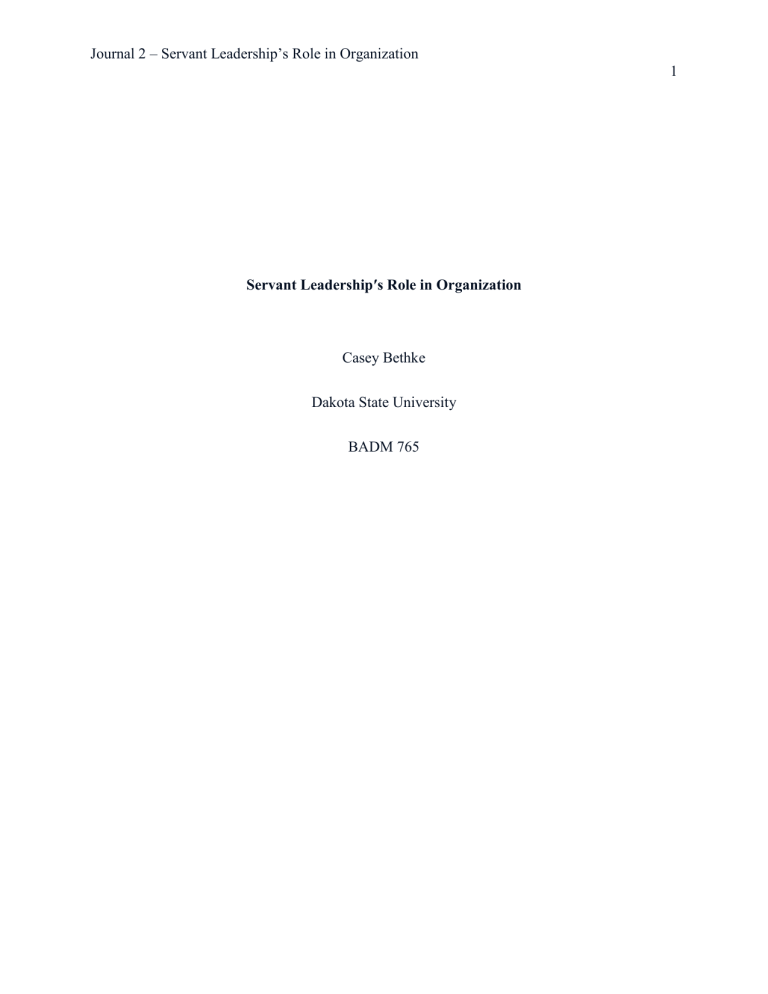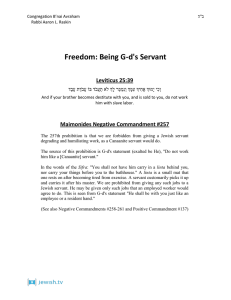
Journal 2 – Servant Leadership’s Role in Organization 1 Servant Leadership′s Role in Organization Casey Bethke Dakota State University BADM 765 Journal 2 – Servant Leadership’s Role in Organization 2 Servant Leadership Impact As a style of leadership, servant leadership emphasizes the stewardship of the organization's resources by the leader. This idea highlights the need for a leader to serve others, including the community, the workforce, and clients. In their cross-cultural investigation of servant leadership in Ghana and the USA, Hale and Fields (2007) examined two quite different cultures. According to their findings, followers in both cultures reacted well to servant leadership. Despite cultural differences, the study emphasized that servant leadership's core characteristics emphasizing follower growth, fostering a culture of trust, and exhibiting authenticity were valued, leading to higher levels of job satisfaction and organizational commitment. Importantly, the research indicated that, regardless of cultural setting, the effects of servant leadership on total business performance were probably universal (Hale & Fields, 2007). In a study published in 2014 Van Dierendonck et al., explored the variations in mechanisms that link servant leadership and transformational leadership to follower outcomes. This study offers insightful information about the function of servant leadership in fostering organizational commitment, job happiness, and overall business success. The study, for instance, emphasizes how servant leadership strengthens affective organizational commitment. Servant leaders inspire loyalty and dedication in their followers by being selfless and people-focused. Servant leaders encourage loyalty and dedication to the organization's vision and goals by fostering a culture of care and concern for others. Van Dierendonck et al. (2014) study shows that servant leadership beneficially promotes discretionary actions or extra-role behaviors. Servant leaders create an atmosphere where employees are encouraged to go above and beyond the call of duty. Employee willingness to devote discretionary effort to the company's success increases. As a result, boosting total firm performance. According to the research (Van Dierendonck et al., 2014), servant Journal 2 – Servant Leadership’s Role in Organization 3 leadership was a more important predictor of follower need fulfillment, organizational commitment, and job satisfaction than transformational leadership. This implies that servant leadership's focus on followers' needs significantly influences followers' outcomes and overall organizational commitment. An investigation by Liden et al., (2014), looked at the impact of servant leadership and a serving culture on organizational performance at the individual and unit levels. In this sense, "serving culture" refers to the common attitudes, convictions, and conduct that foster altruistic behavior within a company. According to the study's findings, a servant leader who supports a serving culture has a considerable impact on an organization's overall unit performance and the job performance of each employee. They discovered that employees performed better on the job, and the performance of the entire unit was positively impacted when the leaders demonstrated servant leadership and the organization's culture was aligned to serve (Liden et al., 2014). These results show that harmonizing corporate culture and leadership style can greatly improve Fourth, according to the authors of the article "Leader Purposefulness within Servant Leadership: Examining the Effect of Servant Leadership, Leader Follower-Focus, Leader GoalOrientation, and Leader Purposefulness in a Large U.S. Healthcare Organization," it is essential for effective servant leadership that the leader's purpose be in line with the needs and goals of their followers. It was further found that such alignment resulted in higher organizational commitment, job satisfaction, and better business performance. This study shows that a leader's sense of purpose can increase servant leadership's efficiency and produce more devoted and productive workers. Leaders may dramatically increase different facets of organizational success when they prioritize the needs of their followers, match their leadership style with a serving culture, and keep a sense Journal 2 – Servant Leadership’s Role in Organization 4 of purpose in their work. The following parts will continue to examine this subject in more detail (Dierendonck et al., 2018). Fifth, in their 2007 study, Dannhauser and Boshoff broadened the purview of servant leadership by investigating its effects in two very different cultural contexts: North America and South Africa. They discovered that servant leadership is globally applicable and positively influences work satisfaction and organizational commitment using the Barbuto and Wheeler servant leadership questionnaire. According to the authors, followers across various cultural contexts respond well to servant leadership, which emphasizes addressing followers' needs, creating trust, and promoting personal growth. As a result, the followers exhibit greater organizational loyalty and experience greater job satisfaction. This study supports the claim made by Dannhauser and Boshoff (2007) that servant leadership can be a universal instrument for enhancing organizational commitment, job satisfaction, and overall firm performance. Sixth, Drury (2004) examined how employee perceptions of servant leadership connect to organizational commitment and job happiness. In this study, workers who thought their managers exhibited servant leadership showed higher job satisfaction and organizational commitment levels. This is due to servant leadership's people-centered strategy, which emphasizes appreciating and advancing the followers. As a result, there is an uptick in organizational dedication and increased job satisfaction due to employees feeling valued and appreciated by the company. Thus, Drury's study from 2004 lends credence to the idea that servant leadership develops organizational commitment, boosts work happiness, and improves overall company success. The study conducted in 2002 by Sendjaya and Sarros, emphasizes the important impact that servant leadership plays in businesses. The authors examine servant leadership in great detail, chronicling its development and examining how it is used in modern enterprises. According to Journal 2 – Servant Leadership’s Role in Organization 5 their research, servant leadership is firmly anchored in the leader's desire to serve others, promoting an organizational culture wherein each employee's needs are given priority, and they all feel appreciated. According to the authors, organizational commitment, job happiness, and company performance are all significantly impacted by servant leadership. They assert that by placing a strong emphasis on serving and developing followers, servant leaders foster an encouraging and empowering work atmosphere. As a result of feeling valued and appreciated, employees have higher job satisfaction in this atmosphere. Additionally, the dedication to serving others fosters a sense of organizational commitment because employees see the company as caring and supportive, encouraging them to commit and make greater contributions to the company’s success (Sendjaya & Sendjaya, and Sarros, 2002). This analysis of servant leadership explores its genesis, development, and organizational applications. Their study illuminates servant leadership’s importance in improving organizational commitment, job happiness, and overall business performance. The essay stresses that a leader's sincere desire to serve others is the foundation of servant leadership. Servant leaders produce a helpful and empowering work environment by prioritizing the needs and development of their followers. As a result of feeling appreciated and respected for their contributions, people work more happily in this setting. Eighth, Sun and Wang (2009) did a study specifically in the context of China, expanding the evidence base and building on servant leadership's worldwide relevance. The authors put up a paradigm for analyzing and evaluating servant leadership in the context of Chinese culture. Their results revealed that the servant leadership style positively increased organizational commitment and job satisfaction in Chinese enterprises, confirming the notion that the benefits of servant leadership are not restricted by region or culture. They said that Chinese cultural values aligned with the servant leader's emphasis on prioritizing the team’s needs and encouraging a climate of Journal 2 – Servant Leadership’s Role in Organization 6 cooperation and trust. As a result, these leaders might increase employee happiness, inspire their teams more effectively, and improve business performance (Sun & Wang, 2009). Liden, Wayne, Meuser, Hu, Wu, and Liao (2015) reiterate the importance of servant leadership in achieving corporate goals. They validated a condensed version of the Servant Leadership Scale (SL-28), demonstrating its usefulness in gauging how servant leadership affects many areas of organizational performance, such as employee commitment and work satisfaction. Their study discovered a favorable correlation between servant leadership, as assessed by the short-form SL-28, and workers' commitment to the company. According to the authors, a leader's emphasis on supporting and empowering their followers enhances job satisfaction. It promotes a sense of loyalty to the organization, which enhances the company’s overall performance (Liden et al., 2015). Last but not least, the study by Jaramillo, Grisaffe, Chonko, and Roberts (2009) focuses on analyzing the effects of servant leadership, particularly on salespeople's inclination to leave their current position. The intention to leave is the study's main topic, but it also indirectly discusses the effect of servant leadership on organizational commitment and work happiness, two interrelated elements. According to the study, salespeople's inclination to leave their current position is significantly negatively correlated with servant leadership. Servant leaders promote their sales team's well-being, development, and progress, fostering a positive and empowering work environment. Servant leaders foster a sense of loyalty, trust, and dedication by respecting and investing in their people. As a result, salespeople are less likely to plan to quit their jobs since they are happier with their jobs and the company. Although the study focuses mostly on the intention to leave, it is significant to note that lower turnover intention correlates with greater organizational engagement and work satisfaction. Salespeople are more likely to strengthen their commitment to Journal 2 – Servant Leadership’s Role in Organization 7 the company and report higher levels of job satisfaction if they feel their superiors value and support them. Committed and satisfied salespeople are more likely to demonstrate discretionary effort, develop solid client connections, and meet sales targets, these favorable results can improve total business performance. Journal 2 – Servant Leadership’s Role in Organization 8 References Dannhauser, Z., & Boshoff, A. B. (2007). Structural equivalence of the Barbuto and Wheeler (2006) servant leadership questionnaire on North American and South African samples. International Journal of Leadership Studies, 2(2), 148-168. Dierendonck, D. van, & Patterson, K. (2018). Practicing Servant Leadership: Developments in Implementation. Drury, S. (2004). Employee perceptions of servant leadership: Comparisons by level, job satisfaction, and organizational commitment. Regent University. Hale, J. R., & Fields, D. L. (2007). Exploring servant leadership across cultures: A study of followers in Ghana and the USA. Leadership, 3(4), 397-417. Jaramillo, F., Grisaffe, D. B., Chonko, L. B., & Roberts, J. A. (2009). Examining the impact of servant leadership on a salesperson’s turnover intention. Journal of Personal Selling & Sales Management, 29(4), 351-365. Liden, R. C., Wayne, S. J., Liao, C., & Meuser, J. D. (2014). Servant leadership and serving culture: Influence on individual and unit performance. Academy of management journal, 57(5), 1434-1452. Liden, R. C., Wayne, S. J., Meuser, J. D., Hu, J., Wu, J., & Liao, C. (2015). Servant leadership: Validation of a short form of the SL-28. The Leadership Quarterly, 26(2), 254-269. Sendjaya, S., & Sarros, J. C. (2002). Servant leadership: Its origin, development, and application in organizations. Journal of Leadership & Organizational Studies, 9(2), 57-64. Sun, J. M., & Wang, B. (2009). Servant leadership in China: Conceptualization and measurement. In Advances in global leadership. Emerald Group Publishing Limited. Journal 2 – Servant Leadership’s Role in Organization 9 Van Dierendonck, D., Stam, D., Boersma, P., De Windt, N., & Alkema, J. (2014). Same difference? Exploring the differential mechanisms linking servant leadership and transformational leadership to follower outcomes. The Leadership Quarterly, 25(3), 544562.







